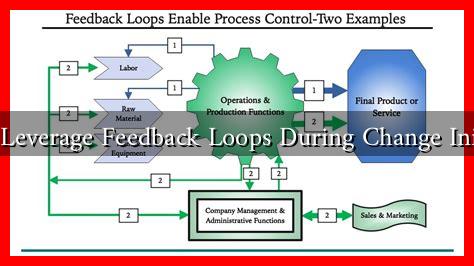-
Table of Contents
- How to Leverage Feedback Loops During Change Initiatives
- Understanding Feedback Loops
- The Importance of Feedback Loops in Change Initiatives
- Strategies for Implementing Feedback Loops
- 1. Establish Clear Objectives
- 2. Utilize Multiple Feedback Channels
- 3. Foster a Culture of Openness
- 4. Analyze and Act on Feedback
- Case Study: Microsoft’s Transformation
- Statistics Supporting Feedback Loops
- Conclusion
How to Leverage Feedback Loops During Change Initiatives
Change is an inevitable part of any organization, whether it’s due to market demands, technological advancements, or internal restructuring. However, managing change effectively can be challenging. One of the most powerful tools at your disposal during these initiatives is the feedback loop. This article explores how to leverage feedback loops to enhance the success of change initiatives, providing valuable insights, examples, and strategies.
Understanding Feedback Loops
A feedback loop is a process in which the outputs of a system are circled back and used as inputs. In the context of organizational change, feedback loops allow leaders to gather insights from employees, stakeholders, and customers, which can inform and refine the change process. This iterative approach not only helps in identifying potential issues early but also fosters a culture of continuous improvement.
The Importance of Feedback Loops in Change Initiatives
Implementing feedback loops during change initiatives can lead to several benefits:
- Enhanced Communication: Feedback loops facilitate open communication channels, ensuring that everyone involved is on the same page.
- Increased Engagement: When employees feel their opinions matter, they are more likely to engage with the change process.
- Early Problem Detection: Regular feedback helps identify issues before they escalate, allowing for timely interventions.
- Data-Driven Decisions: Feedback provides valuable data that can guide decision-making and strategy adjustments.
Strategies for Implementing Feedback Loops
To effectively leverage feedback loops during change initiatives, consider the following strategies:
1. Establish Clear Objectives
Before initiating feedback loops, it’s crucial to define clear objectives for the change initiative. What do you hope to achieve? How will you measure success? Having well-defined goals will help focus the feedback process and ensure that the insights gathered are relevant.
2. Utilize Multiple Feedback Channels
Different stakeholders may prefer different methods of communication. To capture a wide range of insights, consider using various feedback channels, such as:
- Surveys and questionnaires
- Focus groups
- One-on-one interviews
- Anonymous suggestion boxes
- Regular team meetings
3. Foster a Culture of Openness
Encouraging a culture where feedback is valued and acted upon is essential. Leaders should model this behavior by being open to receiving feedback themselves. This can be achieved through:
- Regularly soliciting input from team members
- Actively listening and responding to feedback
- Recognizing and rewarding contributions
4. Analyze and Act on Feedback
Collecting feedback is only the first step; analyzing and acting on it is where the real value lies. Use data analytics tools to identify trends and patterns in the feedback. Then, communicate the findings to stakeholders and outline the actions that will be taken in response. This transparency builds trust and encourages further participation.
Case Study: Microsoft’s Transformation
Microsoft’s transformation under CEO Satya Nadella is a prime example of leveraging feedback loops effectively. Nadella emphasized a growth mindset and encouraged open communication across all levels of the organization. By implementing regular employee surveys and feedback sessions, Microsoft was able to identify areas for improvement and adapt its strategies accordingly. This approach not only improved employee morale but also led to significant growth in the company’s market value.
Statistics Supporting Feedback Loops
Research shows that organizations that actively seek and act on employee feedback can see substantial improvements in performance. According to a study by Gallup, companies with high employee engagement levels outperform their competitors by 147% in earnings per share. This statistic underscores the importance of creating feedback loops that engage employees during change initiatives.
Conclusion
In conclusion, leveraging feedback loops during change initiatives is essential for fostering a culture of engagement, transparency, and continuous improvement. By establishing clear objectives, utilizing multiple feedback channels, fostering openness, and acting on insights, organizations can navigate change more effectively. As demonstrated by Microsoft’s transformation, the benefits of implementing feedback loops can lead to enhanced performance and employee satisfaction. Embrace feedback as a vital component of your change strategy, and watch your organization thrive.
For more insights on effective change management, consider exploring resources from the Prosci Change Management organization.


